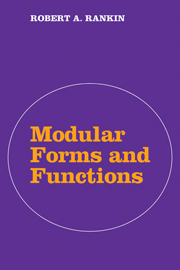Book contents
- Frontmatter
- Contents
- Preface
- 1 Groups of matrices and bilinear mappings
- 2 Mapping properties
- 3 Automorphic factors and multiplier systems
- 4 General properties of modular forms
- 5 Construction of modular forms
- 6 Functions belonging to the full modular group
- 7 Groups of level 2 and sums of squares
- 8 Modular forms of level N
- 9 Hecke operators and congruence groups
- 10 Applications
- Bibliography
- Index of special symbols
- Index of authors
- Subject index
- Frontmatter
- Contents
- Preface
- 1 Groups of matrices and bilinear mappings
- 2 Mapping properties
- 3 Automorphic factors and multiplier systems
- 4 General properties of modular forms
- 5 Construction of modular forms
- 6 Functions belonging to the full modular group
- 7 Groups of level 2 and sums of squares
- 8 Modular forms of level N
- 9 Hecke operators and congruence groups
- 10 Applications
- Bibliography
- Index of special symbols
- Index of authors
- Subject index
Summary
This book has grown out of lectures given in 1963–64 in Indiana University and before that in the University of Cambridge. It aims to provide a reasonably elementary introduction to the theory of elliptic modular functions and forms.
Chapter 1 is concerned with the study of the modular group SL(2, ℤ) and its more important subgroups. These are studied mainly as matrix groups but also as groups of mappings, although it is in the second chapter that the mapping properties are most closely investigated and it is there that fundamental regions are constructed. Since our concern is not with the more general theory of automorphic functions on Fuchsian groups, it is possible to give a relatively simple account.
In another respect our treatment of the theory is fuller than is customary in a textbook on automorphic or modular forms, since it is not confined solely to modular forms of integral weight (dimension). Multiplier systems of arbitrary real weight possess a complicated structure. We have therefore presented the elementary theory in chapter 3 in a more general form than is necessary for our purposes, so that it can be applied to SL(2, ℝ) and its subgroups if desired; it is only in §3.3 that the theory is restricted to subgroups of the modular group.
Chapter 4 contains the basic definitions and properties of modular forms of arbitrary real weight with corresponding multiplier systems. It is important to know the dimensions of vector spaces of modular forms belonging to various subgroups.
- Type
- Chapter
- Information
- Modular Forms and Functions , pp. xi - xivPublisher: Cambridge University PressPrint publication year: 1977



